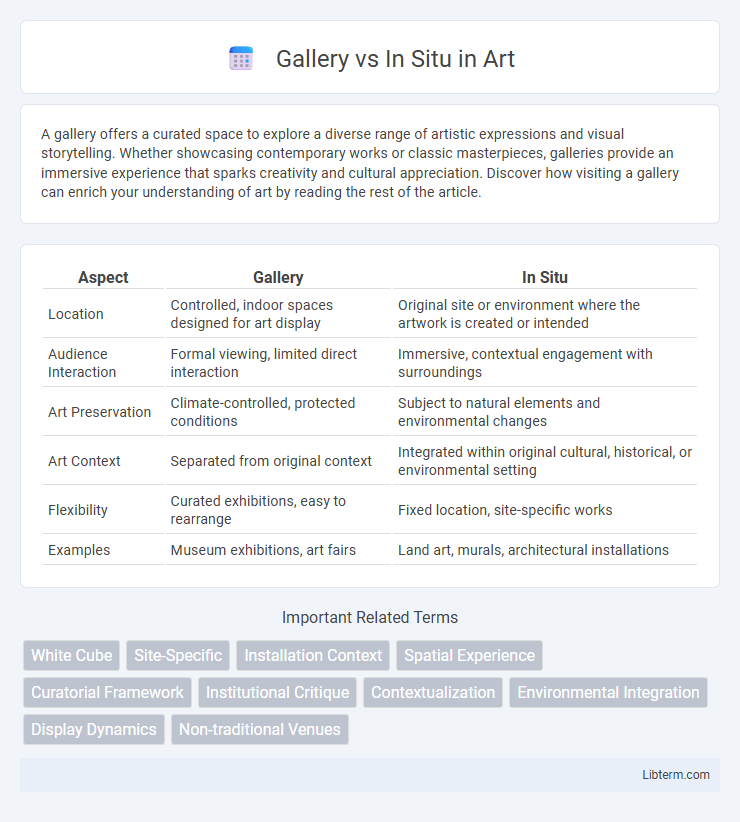A gallery offers a curated space to explore a diverse range of artistic expressions and visual storytelling. Whether showcasing contemporary works or classic masterpieces, galleries provide an immersive experience that sparks creativity and cultural appreciation. Discover how visiting a gallery can enrich your understanding of art by reading the rest of the article.
Table of Comparison
| Aspect | Gallery | In Situ |
|---|---|---|
| Location | Controlled, indoor spaces designed for art display | Original site or environment where the artwork is created or intended |
| Audience Interaction | Formal viewing, limited direct interaction | Immersive, contextual engagement with surroundings |
| Art Preservation | Climate-controlled, protected conditions | Subject to natural elements and environmental changes |
| Art Context | Separated from original context | Integrated within original cultural, historical, or environmental setting |
| Flexibility | Curated exhibitions, easy to rearrange | Fixed location, site-specific works |
| Examples | Museum exhibitions, art fairs | Land art, murals, architectural installations |
Understanding Gallery Exhibitions
Gallery exhibitions showcase curated artworks in controlled environments designed to enhance visual appeal and narrative coherence, optimizing lighting and spatial arrangement for immersive viewer experiences. These exhibitions emphasize the artist's intended presentation, often accompanied by interpretive materials, which facilitate deeper audience engagement with the thematic and aesthetic aspects of the work. Understanding gallery settings involves recognizing their role in framing art within cultural and commercial contexts, contrasting with in situ displays that highlight site-specific interactions.
What Does In Situ Art Mean?
In situ art refers to artwork specifically created and installed in the exact location where it is meant to be experienced, often interacting with the surrounding environment. This form of art emphasizes site-specificity, incorporating architectural, cultural, or natural elements integral to the location. Unlike gallery exhibits that can be relocated or reproduced, in situ art is uniquely tied to its setting, making the physical space an essential component of the artistic expression.
Historical Context: Gallery vs In Situ
Gallery exhibitions provide controlled environments designed to preserve and display artifacts under optimal conditions, reflecting a tradition rooted in curatorial efforts that date back to the Renaissance period. In situ presentations maintain artifacts within their original archaeological or historical settings, emphasizing authenticity and contextual integrity, a practice gaining prominence since the mid-20th century cultural heritage movement. The contrast between gallery and in situ approaches highlights evolving priorities in conservation, interpretation, and public engagement within the history of museum and heritage management.
Curatorial Control in Galleries
Curatorial control in galleries is characterized by carefully curated exhibitions where gallery professionals select, arrange, and interpret artworks to shape the audience's experience. This controlled environment allows for thematic cohesion, consistent lighting, and spatial design that enhance the presentation and narrative of the art. In contrast, in situ exhibitions lack this centralized curatorial authority, as artworks are integrated into their natural or original contexts, often allowing for more spontaneous and site-specific interpretations.
Authenticity of In Situ Installations
In situ installations maintain authenticity by preserving the artwork within its original context, allowing viewers to experience the piece as intended by the artist. The environmental and spatial conditions contribute to the meaning and impact, ensuring a direct connection between the work and its location. This authenticity contrasts with gallery settings, where artworks are often removed from their natural surroundings, potentially diminishing their intended message and experiential value.
Audience Experience: Contrasts and Impacts
Gallery exhibitions offer curated environments where viewers engage with art through controlled lighting, spatial design, and detailed descriptions, fostering focused reflection and appreciation. In situ installations immerse audiences within the artwork's natural or original context, enhancing emotional connection and sensory interaction by blending art seamlessly into everyday environments. These contrasting experiences influence perception, accessibility, and the overall impact of the artwork, shaping how diverse audiences interpret and value creative expression.
Challenges in Preservation and Conservation
Gallery environments offer controlled conditions with regulated lighting, humidity, and temperature, which facilitate the preservation and conservation of artworks. In situ preservation faces challenges such as exposure to variable environmental factors, pollutants, and physical wear, increasing the risk of deterioration. Conservation efforts in situ require specialized techniques to mitigate damage from natural elements while maintaining the artwork's authenticity and context.
Accessibility: Public vs Institutional Spaces
Gallery spaces often emphasize accessibility by providing open public access, allowing diverse audiences to engage with art in welcoming, easily reachable locations. In situ artworks are typically situated within institutional or private settings, limiting accessibility to specific visitor groups or requiring special permissions. Public galleries foster inclusive cultural experiences, whereas in situ installations prioritize context-specific engagement within controlled spaces.
Influence on Artistic Intent and Interpretation
Gallery settings provide artists with controlled environments to present their work, allowing precise manipulation of lighting, space, and context that shapes viewer interpretation according to the artist's intent. In situ art interacts dynamically with its surroundings, embedding cultural, historical, or environmental elements that influence audience perception through site-specific relevance. The contrast between gallery and in situ presentation fundamentally alters the reception and meaning of artworks, highlighting the importance of context in artistic communication.
Future Trends: Hybrid Exhibition Models
Hybrid exhibition models combining gallery spaces with in situ experiences are reshaping the future of art presentation, enhancing accessibility and audience engagement. By integrating digital technologies such as augmented reality and virtual tours, these models create immersive, multifunctional environments that appeal to diverse and global audiences. The evolution toward hybrid formats supports sustainable practices and offers dynamic opportunities for artists and curators to experiment beyond traditional gallery constraints.
Gallery Infographic

 libterm.com
libterm.com